Federal candidates depend on financial sector more than any other for campaign money
All data in this analysis and accompanying charts are via the Center for Responsive Politics, and can be found at InfluenceExplorer.com
Candidates running for federal office are two-thirds more dependent on donors from the finance, insurance and real estate (FIRE) sector for campaign contributions than any other sector. Through the second quarter of 2012, federal candidates have relied on the sector for 15.2% of their itemized (over $200) contributions, solidly ahead of their dependence on the next closest competitors — health interests (at 8.9%) and lawyers and lobbyists (at 8.8%).
This is not a new phenomenon. In each of the last seven election cycles, federal candidates have depended on the finance sector for between 15% and 17% of their contributions at the same point in the cycle. But with tax reform being high on the agenda no matter who is elected and the finance sector eager to continue to shape the implementation of Wall Street reform, the contributions are as important as ever.
What is different this cycle is that FIRE contributions are solidly supporting Republicans for the first time since 2000. Through the second quarter of 2012, 54.8% of finance industry contributions to federal candidates went to Republicans, up dramatically from 44.3% in 2010 (even after the passage of Dodd-Frank) and 42.2% in 2008.
This shift has taken place in the House, the Senate, and as most frequently reported, the presidential race. In the battle to be president, our calculations show that 58.6% of all financial sector itemized campaign donations going to Republican candidates, up from 38.6% in 2008. To be clear, this total only includes money directly to candidates. If we looked at super PACs, finance money would be titled even more Republican. Through the second quarter, we calculate that Mitt Romney’s Restore Our Future super PAC depended on the finance sector for 43% of its money, and 75% of the finance money was coming directly from the securities and investment sub-sector (aka Wall Street). No other sector of the economy even came close in helping to “Restore Our Future.”
Additionally, of the candidates who raised $150,000 through the second quarter, 38% depended most heavily on FIRE donors for contributions, as compared to 13.5% who depended on labor money most heavily, 11.8% who depended on health interests most heavily, and 11.7% who depended on lobbying/lawyers most heavily. In other words, roughly three times as many candidates depend on the finance sector for the plurality of their contributions than any other sector of the economy.
It’s also important to point out that there is great variation across different candidates. Some are much more reliant on the financial industry than others. Through the second quarter of 2012, 87 candidates running for office this cycle had relied on the finance sector at least one quarter of their itemized contributions, and 33 candidates depended on FIRE for at least one third of their itemized contributions. We name names further down (so keep reading).
Ranking the Sectors
Figure 1 compares the overall share of itemized contributions across the most active sectors. Through the second quarter, FIRE contributions account for 15.2% of all itemized (over $200) donations to candidates, followed by Health (8.9%) and Lawyer/Lobbyists (8.8%). Ideological/Single-Issue groups account for 6.1% of itemized contributions, followed by Communications/Electronics (4.3%) and Energy/Natural Resources (4.2%). All totals combine individual and PAC contributions.
Figure 1. Share of total federal candidate money from most active sectors
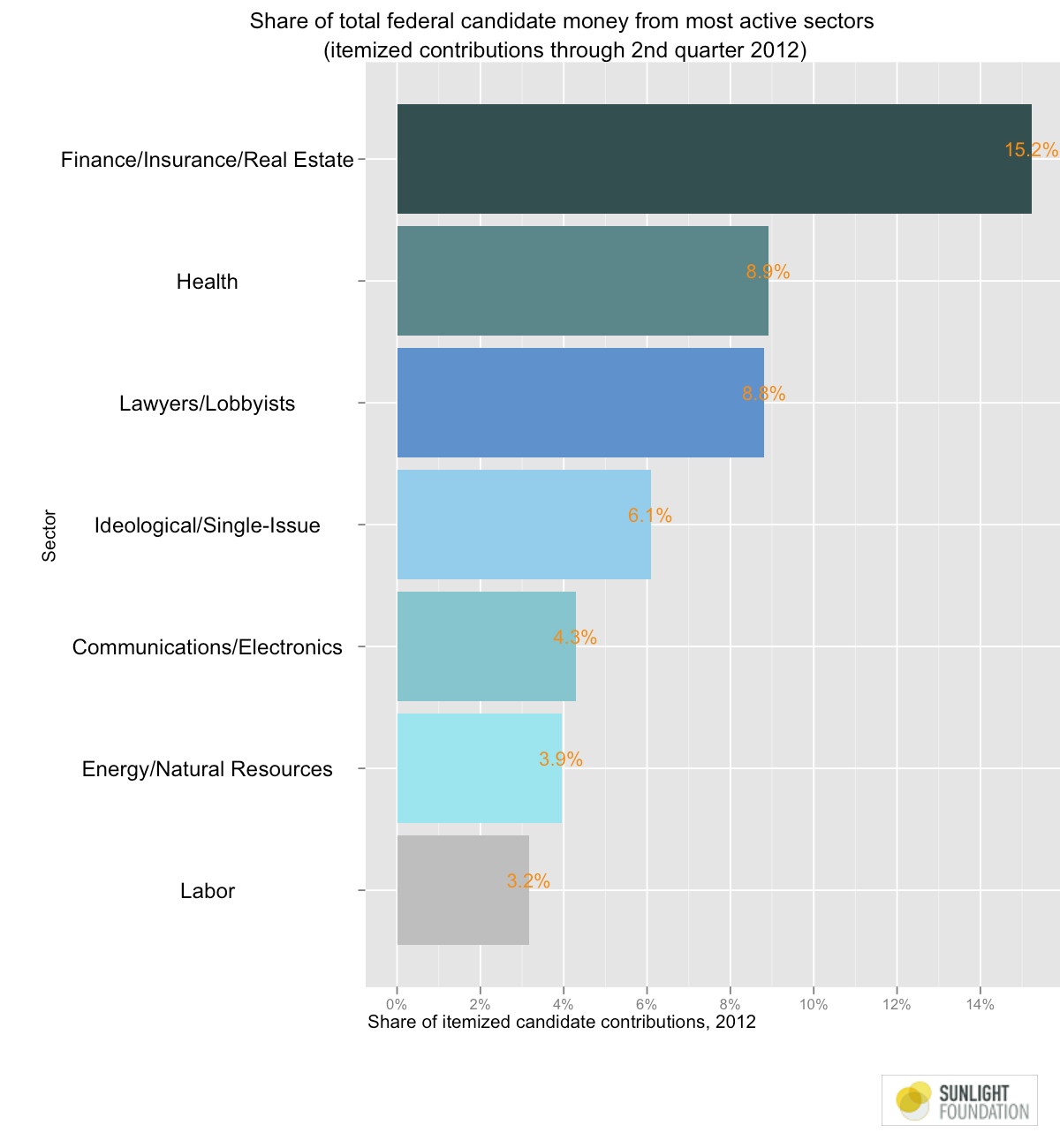 Figure 2 lays out the time trends since 2000 (through the second quarter of the election year, to be consistent). In general, the shares have remained mostly stable, with one major exception: Labor. In 2000, labor funds accounted for just under 10% of candidate money. Today, that share is closer to 3%. There is also an intriguing drop-off in the share of money coming from single-issue/ideological groups. Those donations peaked in 2006 at 9.5% of all itemized donations. They have since fallen to 6.1% of contributions
Figure 2 lays out the time trends since 2000 (through the second quarter of the election year, to be consistent). In general, the shares have remained mostly stable, with one major exception: Labor. In 2000, labor funds accounted for just under 10% of candidate money. Today, that share is closer to 3%. There is also an intriguing drop-off in the share of money coming from single-issue/ideological groups. Those donations peaked in 2006 at 9.5% of all itemized donations. They have since fallen to 6.1% of contributions
Figure 2. Share of total federal candidate itemized money from different sectors
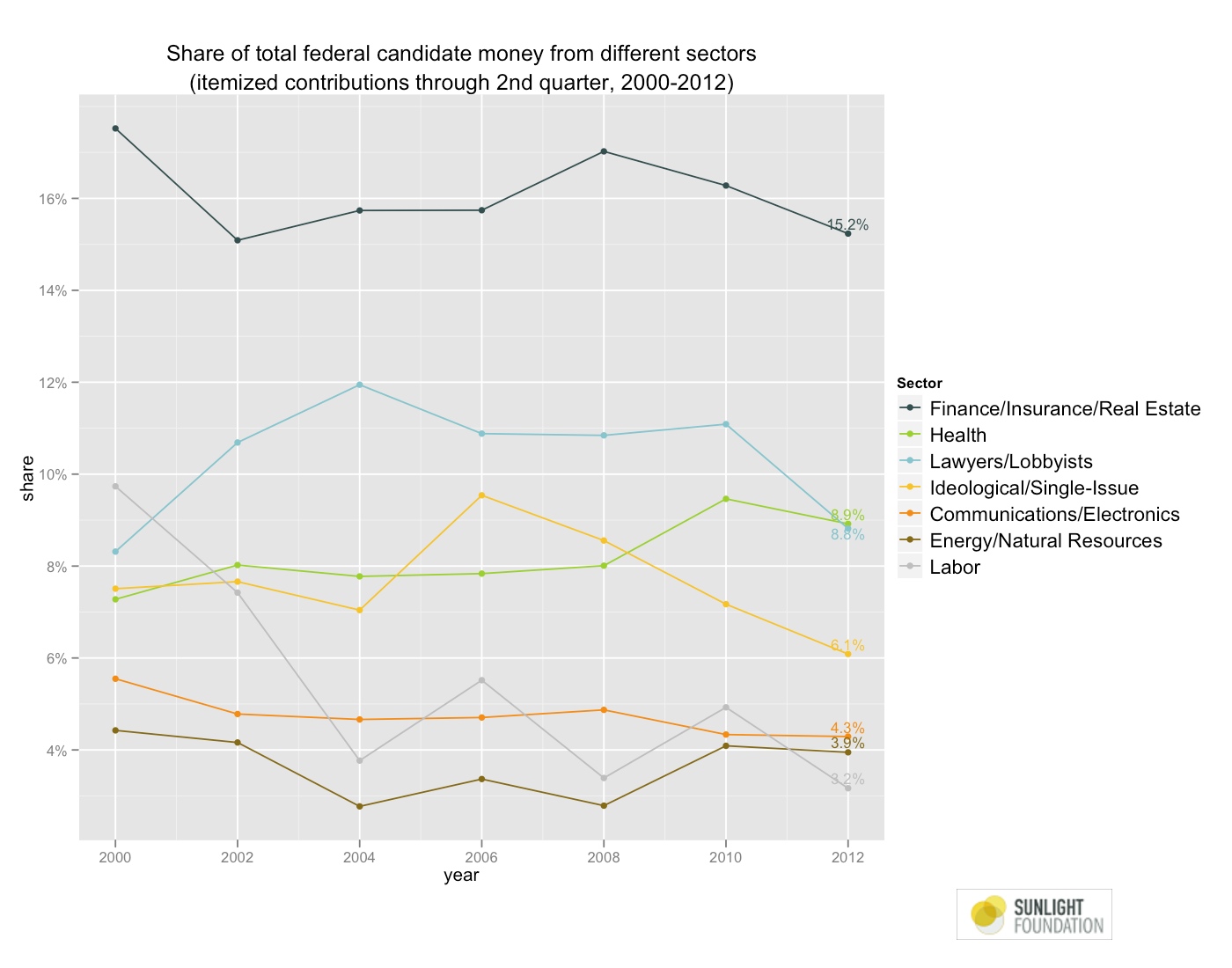
Another way to examine dependence is to see which sectors rank as the top sector for candidates (Figure 3). Again, finance comes out on top. Of the 839 candidates who had raised at least $150,000 in campaign funds through the second quarter of 2012, 38% depended most heavily on contributions from the FIRE sector. By contrast, 13.5% depended most heavily on labor, which ranked seventh in Figure 1. Health was at 11.8% of candidates, lawyers/lobbyists at 11.7% of candidates and another 7.3% of candidates running depended most heavily on ideological/single issue groups for their contributions.
It is intriguing that while Labor only counts for 3.2% of all contributions to candidates, almost one in seven candidates are more dependent on labor than on any other sectors. What this strongly suggests is that labor concentrates its efforts on a limited number of candidates.
Figure 3. Share of candidates most dependent on different sectors
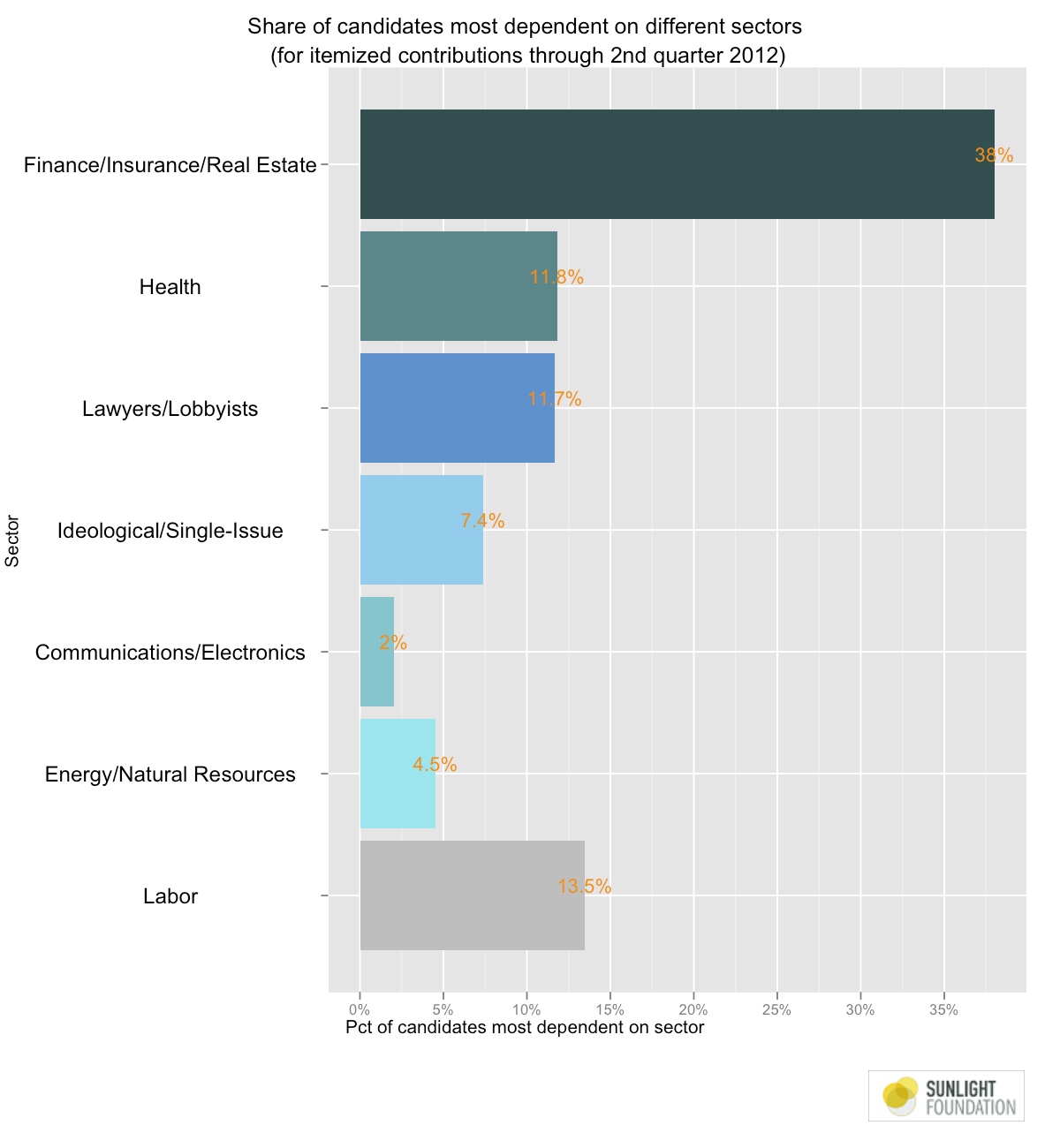
Figure 4 turns the focus to the dependence of candidates running for different offices. Senate candidates are slightly more dependent on FIRE money (16.8%) than House candidates (15%). Presidential candidates are least dependent at 14%, though this money only covers contributions directly to the presidential campaign.
A few other notable points here, to be explored in more detail in subsequent posts. Senate candidates are noticeably more dependent on lawyers/lobbyists (12.2%) than House candidates (8%) or presidential candidates (7.1%). House candidates get slightly more money from the health sector (9.8%) than Senate candidates (8.3%).
Figure 4. Share of total itemized federal candidate money, by sector

Figure 5 looks at these trends over time. Again, the patterns are pretty stable. Again, a few non-finance related trends are of interest (to be explored in subsequent posts). For one, the big decline in labor contributions is in House races. For another, lawyer/lobbyist giving to presidential campaigns has declined substantially, which no doubt has to do with Obama’s refusal to take money from registered lobbyists.
Figure 5. Share of total candidate money from different industries
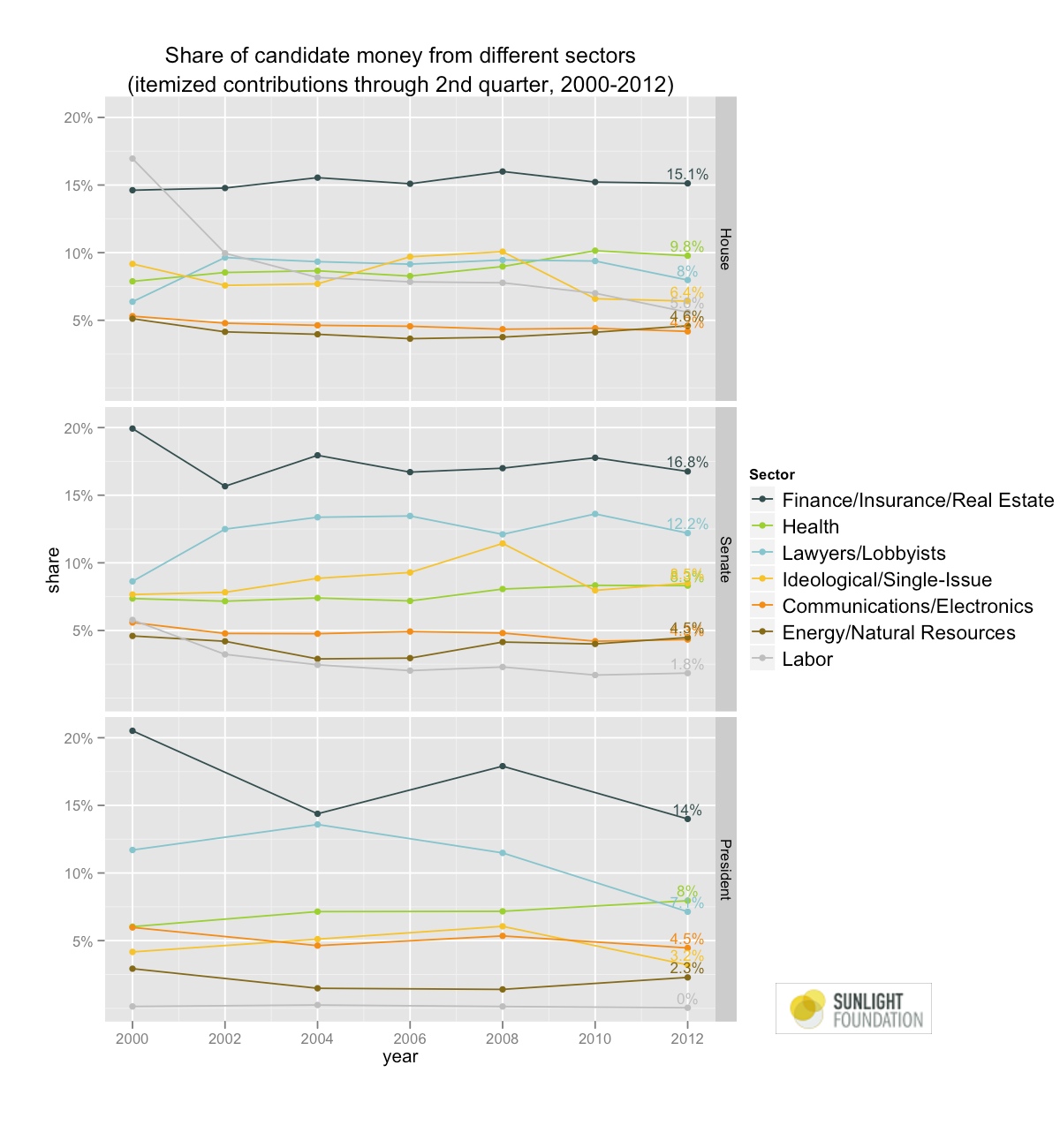
The Republican turn
Turning to the partisan trends, it’s clear that the FIRE sector has taken a right turn this election. Much has been written about Wall Street’s turn from Obama and embrace of Romney. The data reflect this. Notably, the seven organizations whose employees have given the most to Romney are all banks: Goldman Sachs, JP Morgan Chase, Morgan Stanley, Bank of America, Credit Suisse Group, Citigroup and Barclays. The eighth is a law firm, Kirkland & Ellis, followed by another bank, Wells Fargo and consulting firm Pricewaterhouse Coopers.
Figure 6. Top contributors to Romney’s campaign through second quarter, 2012, by organization employees
 For Romney’s full fundraising profile, check out his page on Influence Explorer.
For Romney’s full fundraising profile, check out his page on Influence Explorer.
Overall, in 2012, 58.2% of FIRE presidential contributions have gone to Republican candidates (primarily Romney) through the second quarter. This is a dramatic change from 2008, when the FIRE sector gave only 38.6% of its direct presidential campaign contributions to Republican candidates. Still, the Republican share higher in 2000 at this point in the cycle, when 65.9% of contributions went to Republicans when George W. Bush was running.
The Republican shift among finance industry donors goes beyond the presidential race. The FIRE sector has gone from solidly supporting Democrats in the House in 2010 to solidly supporting Republicans in 2012. It has also come to near partisan parity in the Senate after solidly supporting Democrats in 2010. (See Figure 6.)
Perhaps the strong anti-Dodd Frank rhetoric coming from Republicans, with lots of promises to repeal, is helping to win money from the financial sector. More likely it has to do with who is in the majority. With Republicans back in the majority in the House, the financial industry has gone back to supporting them, as the industry did when Republicans were last in the majority, in 2006. In the Senate, the last cycle Republicans had a majority, 2000, Republicans also received the majority of money coming from the finance sector.
Figure 7. Republican share of finance sector campaign contributions, by office
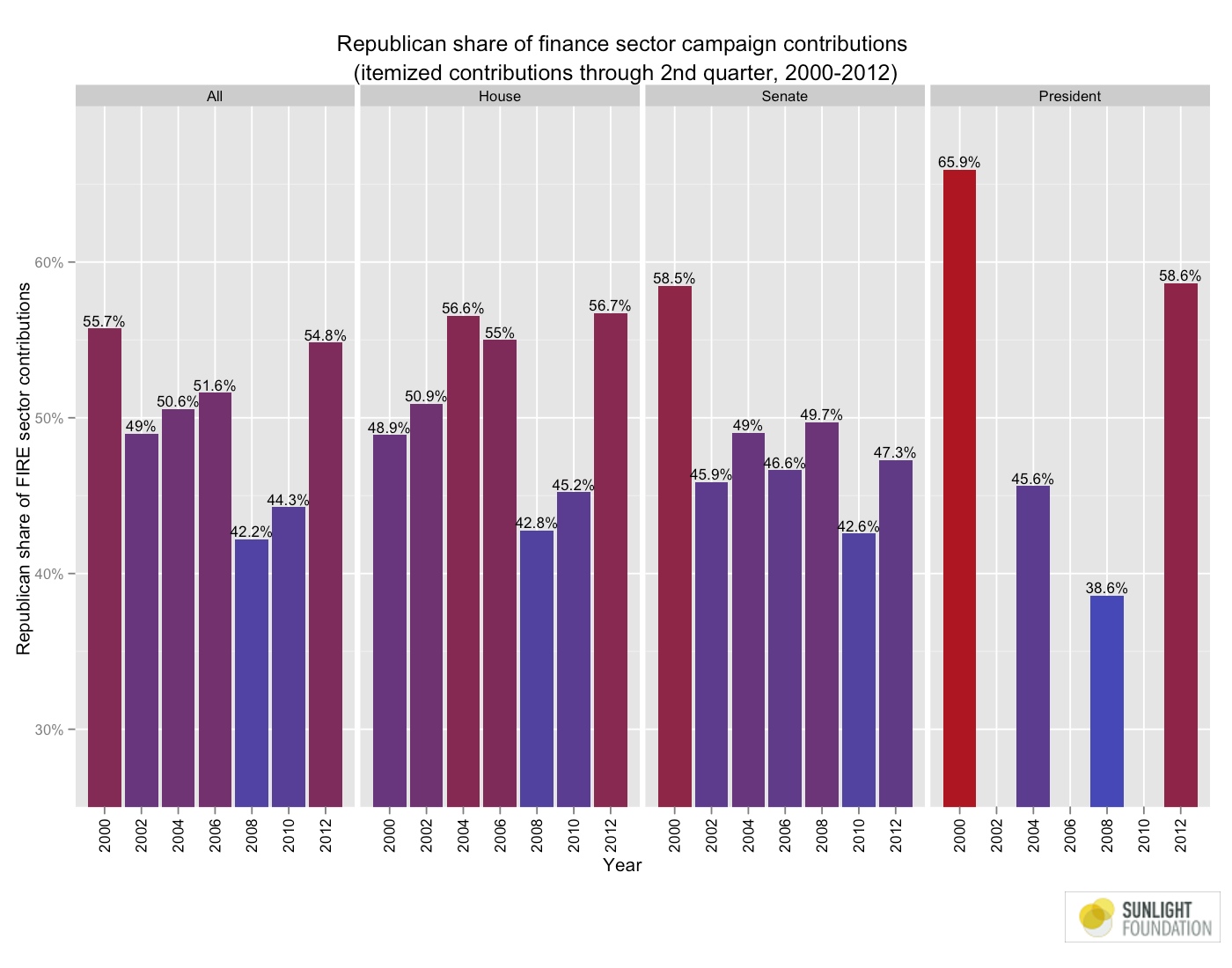
Which members depend most on the finance sector?
While we often tend to look at money in absolute numbers, not all candidates need to raise the same amounts of money. Investigating contributions by shares (as opposed to absolute numbers) gives us a much better sense of how much candidates rely on a particular sector, in this case finance.
This reliance is likely to be the best indicator of how responsive candidates are going to be to a particular industry’s needs. After all, they don’t want to risk alienating an industry that accounts for a significant source of their campaign cash. And equally important, raising money from an industry means spending many hours with executives and employees from that industry and listening attentively to their concerns and arguments.
Table 1 presents the 20 House candidates who have relied the most on the FIRE sector for itemized (over $200) contributions through the second quarter of this year (and raised at least $150,000 through the end of the quarter, the cut-off for being included in the tables below). All have so far relied on FIRE contributors for at least 36.7% of their contributions. Four, including House Financial Services Committee Chair Spencer Bachus (R-AL) depend on financial sector money for at least half of their itemized contributions, a remarkable level of dependence on a single industry. Bachus is at 55%.
The other four over 50% are Christopher D. Meek, a Republican challenger in Connecticut (61.1%), Scott Garrett, a New Jersey incumbent Republican (55.6%) and Mark Greenberg, a Republican challenger in Connecticut (53.8%). Among the 16 incumbents, all 16 are members of the House Financial Services Committee, which has oversight of the financial services industry.
Demonstrating the FIRE sector’s tilt towards Republicans this cycle, 15 of the 20 House candidates most reliant on financial services contributions are Republicans.
Table 1. House candidates most reliant on FIRE contributions
| Candidate | Share from FIRE | District | 2012 total itemized | 2012 share from FIRE | Financial Services |
|---|---|---|---|---|---|
| Christopher D. Meek (R) | 61.10% | CT-04 | $187,110 | $114,360 | N |
| Scott Garrett (R) | 55.60% | NJ-05 | $1,650,707 | $918,038 | Y |
| Spencer Bachus (R) | 55.00% | AL-06 | $2,161,586 | $1,188,925 | Y |
| Mark Greenberg (R) | 53.80% | CT-05 | $268,255 | $144,246 | N |
| Gregory W. Meeks (D) | 49.10% | NY-05 | $506,158 | $248,500 | Y |
| Randy Neugebauer (R) | 46.80% | TX-19 | $1,138,228 | $532,636 | Y |
| Daniel B. Barry (R) | 43.70% | NC-09 | $248,916 | $108,900 | N |
| Jeb Hensarling (R) | 43.60% | TX-05 | $2,229,399 | $971,547 | Y |
| Randy Altschuler (R) | 42.70% | NY-01 | $1,302,959 | $556,870 | N |
| Ed Royce (R) | 42.50% | CA-39 | $1,966,922 | $836,105 | Y |
| Jim Himes (D) | 42.30% | CT-04 | $2,065,032 | $873,192 | Y |
| Blaine Luetkemeyer (R) | 42.10% | MO-03 | $678,576 | $285,835 | Y |
| Patrick McHenry (R) | 42.10% | NC-10 | $896,239 | $377,250 | Y |
| Barney Frank (D) | 40.60% | MA-04 | $686,228 | $278,700 | Y |
| Bill Huizenga (R) | 40.50% | MI-02 | $676,561 | $274,301 | Y |
| John Campbell (R) | 38.90% | CA-45 | $983,394 | $382,100 | Y |
| John Carney (D) | 37.10% | DE-01 | $931,103 | $345,600 | Y |
| Gwen Moore (D) | 37.10% | WI-04 | $528,235 | $195,755 | Y |
| Carolyn B. Maloney (D) | 37.00% | NY-12 | $1,368,449 | $505,681 | Y |
| David Schweikert (R) | 36.70% | AZ-06 | $1,219,887 | $448,200 | Y |
As we noted in an analysis earlier this year (done in collaboration with Planet Money and This American Life), members of Congress who serve on the House Financial Services Committee on average raise $181,799 more than they otherwise would. This analysis highlights how they are able to raise that money: by relying on contributions from the wealthy FIRE sector.
For a complete list of House candidates, click here.
Turning to the top 20 senators most dependent on the FIRE sector for itemized contributions, we get a number of senators not currently up for re-election, but actively raising for their next re-election. Not surprisingly, the two Senators most reliant on FIRE are the Senate Banking Committee Chairman (Tim Johnson (D-SD), at 54%) and ranking member (Richard Shelby (R-AL), at 57%). It doesn’t take much imagination to see how they would rely on the financial services industry for the bulk of their contributions.
Of the 18 incumbents, only half (Shelby, Johnson, Warner, Bennet, Crapo, Toomey, Reed, Johanns, and Hagan) are on the Senate Banking Committee. This list of those not on the Banking Committee includes Senate Majority Leader Mitch McConnell (R-KY) at 26.3%
Of the Senators up for re-election, Massachusetts Republican Scott Brown (also not on the Banking Committee) is in the most contested race. For those keeping score, his Democratic opponent, Elizabeth Warren, has received 15.9% of her itemized contributions from financial sector donors – well behind Brown at 25.7%, but just above the median share of 15.6%
Overall, 13 of the 20 Senators on this list are Republicans. Two are challengers with long-shot candidacies: Barry Hinckley or Rhode Island and Wendy Long of New York.
Table 2. Senators and Senate candidates most reliant on FIRE contributions
| Candidate | Share from FIRE | District | 2012 total itemized | 2012 from FIRE | Banking |
|---|---|---|---|---|---|
| Richard C. Shelby (R) | 57.00% | AL | $305,450 | $174,250 | Y |
| Tim Johnson (D) | 54.00% | SD | $957,193 | $516,760 | Y |
| Mark Warner (D) | 41.40% | VA | $1,923,291 | $797,190 | Y |
| Michael F. Bennet (D) | 34.90% | CO | $668,018 | $232,856 | Y |
| Mike Crapo (R) | 31.20% | ID | $473,136 | $147,410 | Y |
| Pat Toomey (R) | 29.20% | PA | $1,752,100 | $511,155 | N |
| Jack Reed (D) | 29.20% | RI | $151,800 | $44,250 | Y |
| Tom Carper (D) | 28.50% | DE | $2,575,454 | $733,340 | N |
| Mike Enzi (R) | 27.60% | WY | $185,690 | $51,250 | N |
| Barry Hinckley (R) | 27.60% | RI | $657,325 | $181,400 | N |
| Bob Corker (R) | 27.40% | TN | $8,704,411 | $2,384,012 | Y |
| Wendy Long (R) | 27.20% | NY | $282,760 | $77,000 | N |
| Rob Portman (R) | 26.50% | OH | $486,526 | $128,951 | N |
| Mitch McConnell (R) | 26.30% | KY | $5,302,411 | $1,394,849 | N |
| Scott Brown (R) | 25.70% | MA | $9,875,834 | $2,536,470 | N |
| Michael O. Johanns (R) | 25.10% | NE | $222,141 | $55,750 | Y |
| Chris Coons (D) | 23.90% | DE | $700,702 | $167,155 | N |
| Kelly Ayotte (R) | 23.30% | NH | $454,497 | $106,110 | N |
| Kay R. Hagan (D) | 23.10% | NC | $1,296,937 | $299,500 | Y |
| Orrin G. Hatch (R) | 22.70% | UT | $6,091,069 | $1,383,971 | N |
Note: this list does not include Senators who have already announced their retirement. Sens Nelson (D-NE) and Snowe (R-ME) would have been in the top 20 otherwise.
Overall, Senators who sit on the Banking and Housing Committee and House members who sit on the Financial Services Committee tend to be the most dependent on FIRE contributions. On average, these members get 29.2% of their itemized campaign cash from finance sector donors, whereas members who don’t sit on those committees average 12.5% of their donations from the FIRE sector.
For a complete list of Senate candidates, click here.
Overall, though just 8.8% of the candidates who raised $150,000 through the second quarter are members of the key banking committees 18.8% of the FIRE contributions went to these members, a ratio of more than 2-to-1.
Figures 7 looks at the distribution across members. Among Senate Banking and House Financial Services Committees, and finds that it’s most common the find dependencies in the 20-30% range. Below 10% just doesn’t happen. Across other candidates, and most depend on FIRE donors for around 10% of their total itemized contributions. Which is still tends to be more than any other sector.
Figure 8. Distribution of all House/Senate candidates

Conclusion: What does it add up to?
Each election, members of Congress have to raise remarkable sums of cash to get re-elected. To do so, candidates have to cultivate a wide range of donors. But in terms of sheer numbers, none are more important than donors from the finance, insurance and real estate (FIRE) sector. On average, federal candidates running for re-election get 15.2% direct itemized contribution dollars from these donors.
These donors are especially important to the re-election campaigns of members of the Senate Banking and House Financial Services Committees. These members get 29.2% of their direct itemized contribution dollars from these donors.
What does this money buy? For one, it buys access. It buys face time at fundraisers and a chance to make sure that members of Congress hear about the concerns of the financial sector – over and over and over again.
But at these high concentrations, it also buys dependence. Dozens of members of Congress are at a point where they can’t really run for office without the support of donors from this sector. And that’s a troubling proposition, given the fiscal and financial sector policy that’s at stake.

